Highlights and access methods of Horyuji Temple (Nara Prefecture)
English | Japanese
Horyuji Temple is the head temple of the Shotoku Sect located in Ikaruga Town, Ikoma District, Nara Prefecture. It was founded by Emperor Suiko and Prince Shotoku in 607. Although it was once destroyed by fire, it was rebuilt about 1300 years ago and is now the world's oldest existing wooden architecture group. Horyuji Temple, along with Himeji Castle, were the first sites in Japan to be registered as UNESCO World Heritage Sites.
In this article, we will explain the attractions of Horyuji Temple in Nara Prefecture and how to access it for those who are traveling to Japan from overseas.
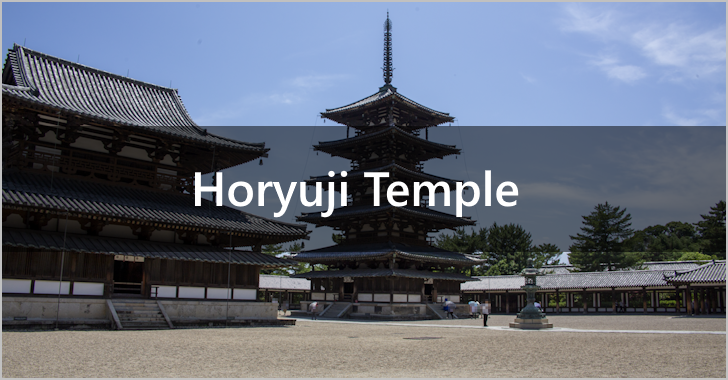
(Last modified: )
(Prefecture : Nara , Category : Temples)
Table of contents
Highlights of Horyuji Temple
We will introduce the highlights of Horyuji Temple.
Nandaimon
The Nandaimon(South Great Gate) is often considered the main entrance to Horyu-ji Temple. It is the first gate you pass through when entering the temple via the main approach. Originally, it is said to have been located near the current Chumon(Middle Gate) when Horyu-ji was founded, but it was moved to its present location as the temple grounds were expanded. The existing gate was reconstructed in 1438 and has been designated a National Treasure.
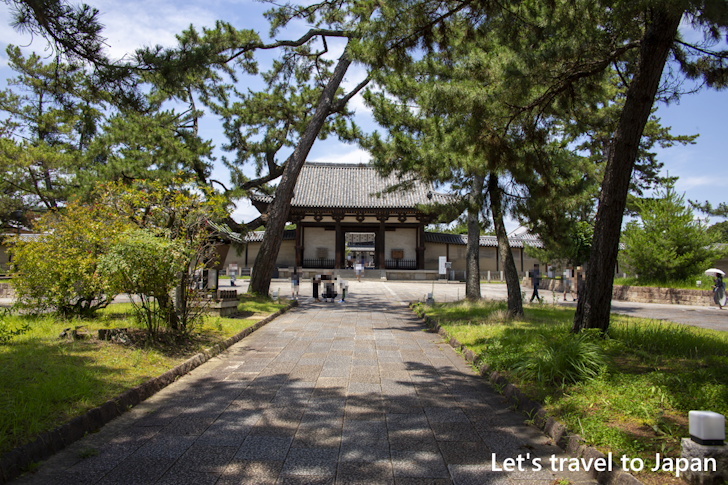
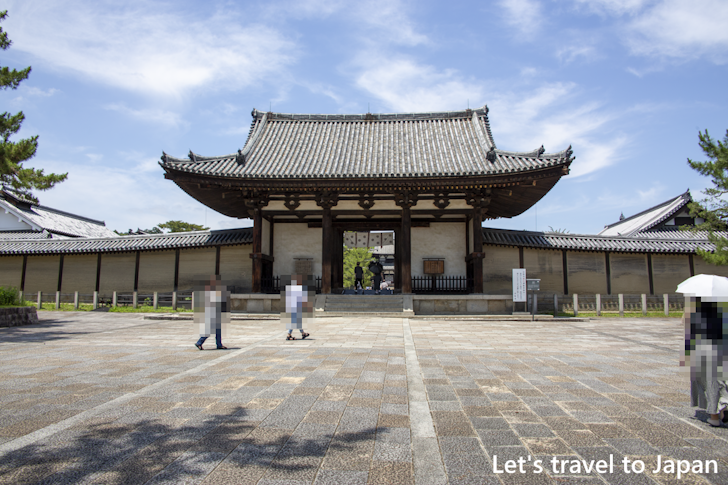
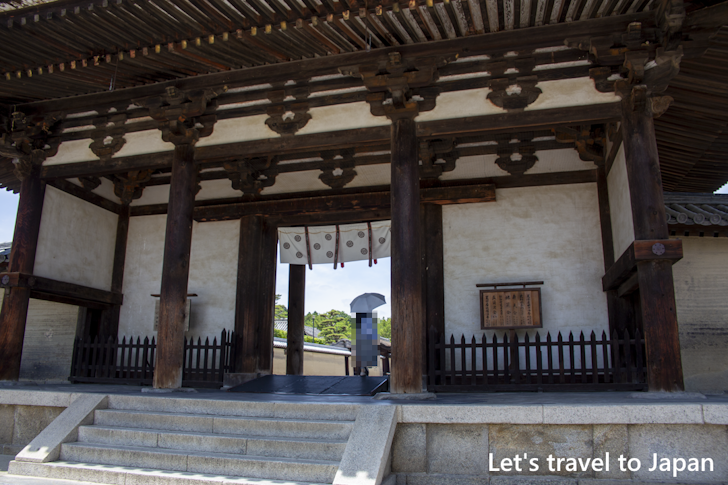
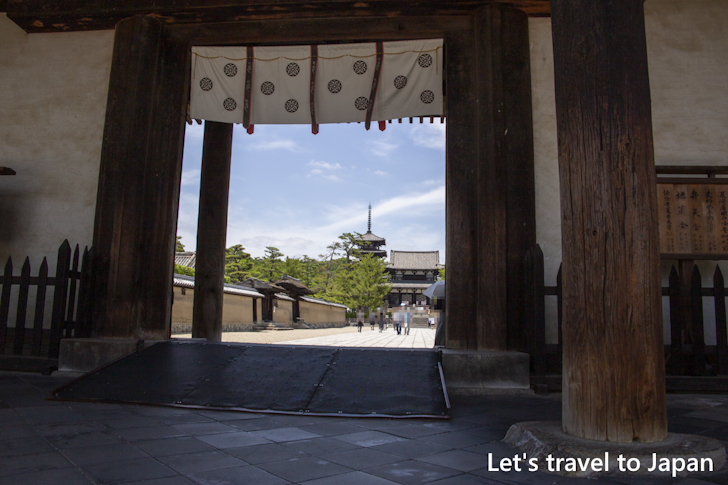
Chumon
Upon passing through the Nandaimon, what comes into view is the Saiin Garan, a complex known as the world's oldest wooden structures. The Chumon(Middle Gate) serves as the entrance to this Saiin Garan. The pillars of the Chumon are known as entasis columns, which are thicker in the middle and taper towards the top. This gate has been designated as a National Treasure. Note that the Chumon is currently not accessible, so one must enter the Saiin Garan from a different entrance.
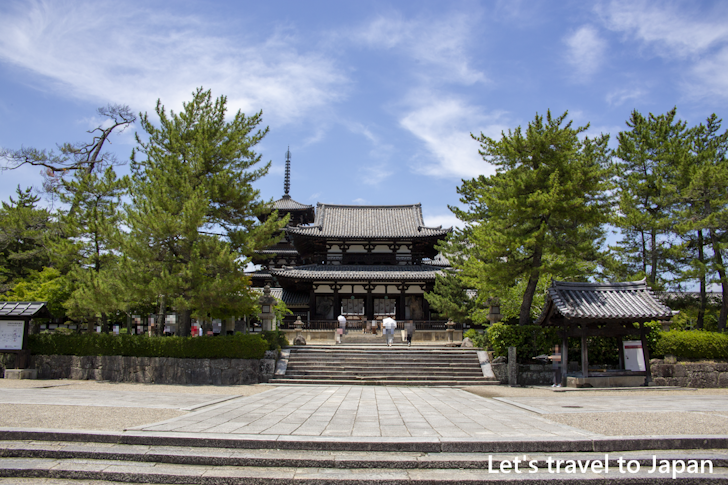
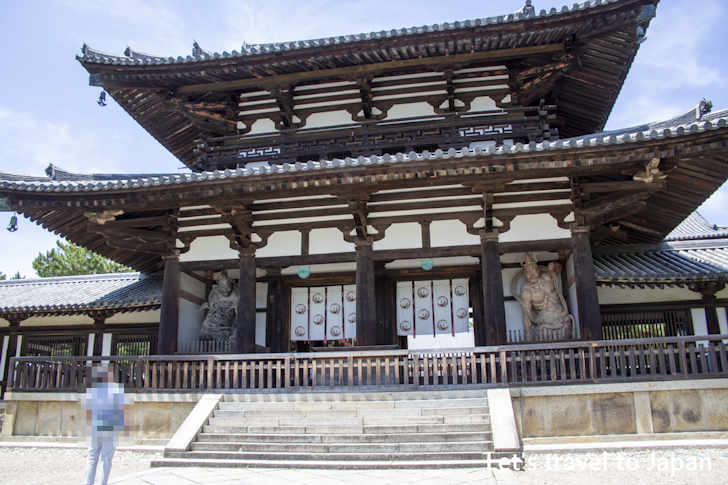
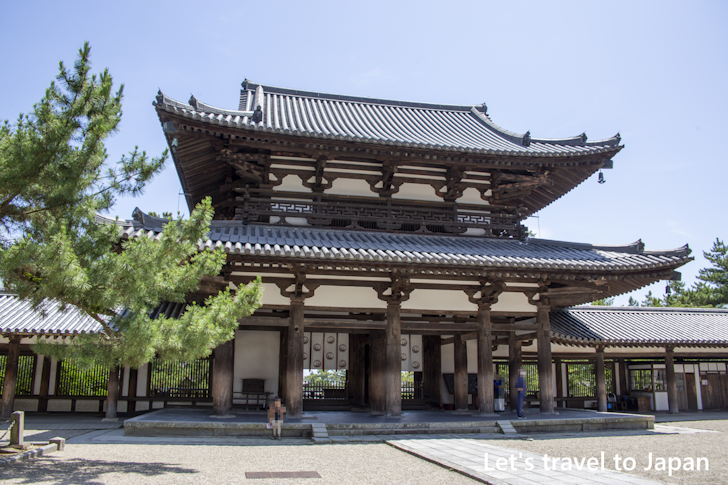
At the Chumon, two Statue of Kongo Rikishi made from molded clay are enshrined, one on each side. Both statues have a height of approximately 380 cm; the one on the right is in the "Agyo" form, while the one on the left is in the "Ungyo" form. They have been designated as Important Cultural Properties.
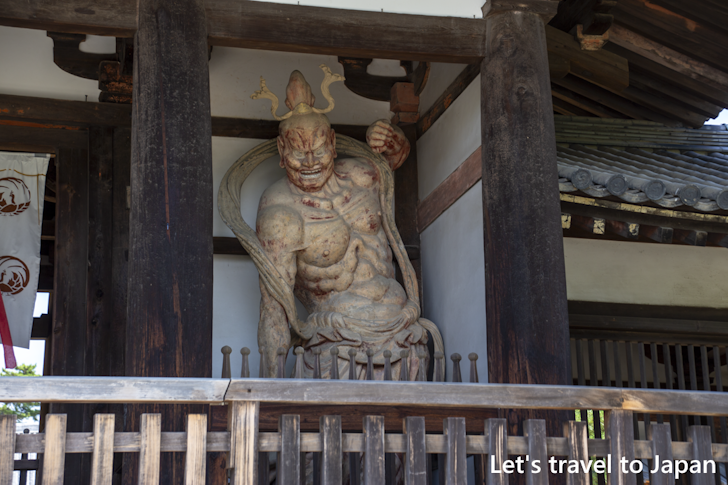
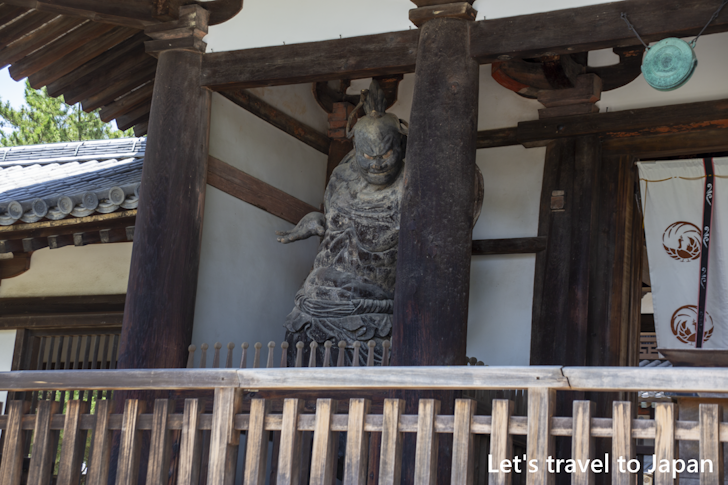
Kondo
The Kondo(Golden Hall) is the most important structure within the Saiin Garan complex. While the exact year of the current Kondo's reconstruction is not known, it is estimated to have been rebuilt before 693 based on historical documents, making it the world's oldest wooden structure.
Inside the hall, various Buddhist statues, all of which are designated as National Treasures, are enshrined. These include the Shaka Triad, the Yakushi Nyorai statue, the Amida Triad, the statue of Kichijoten, the statue of Bishamonten, and statues of the Four Heavenly Kings.
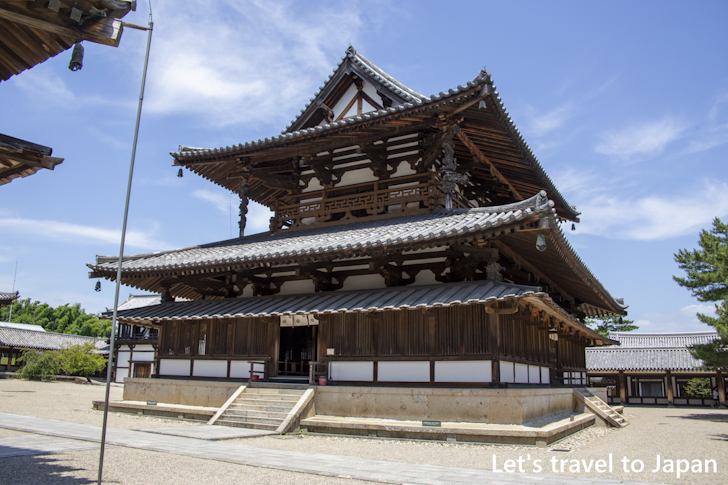
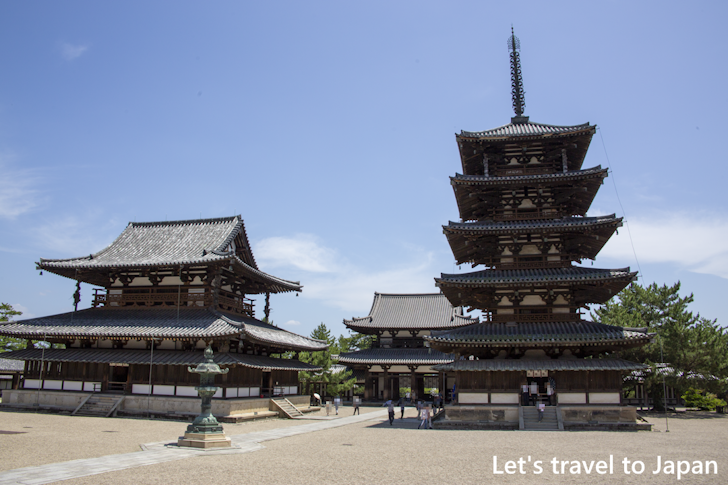
The Kondo features architectural elements characteristic of the Asuka period, such as "Manji-kuzushi" railings and "Hitoji-gata Warizuka" brackets. These features, including entasis columns, are also found in the Middle Gate and the Five-storied Pagoda.
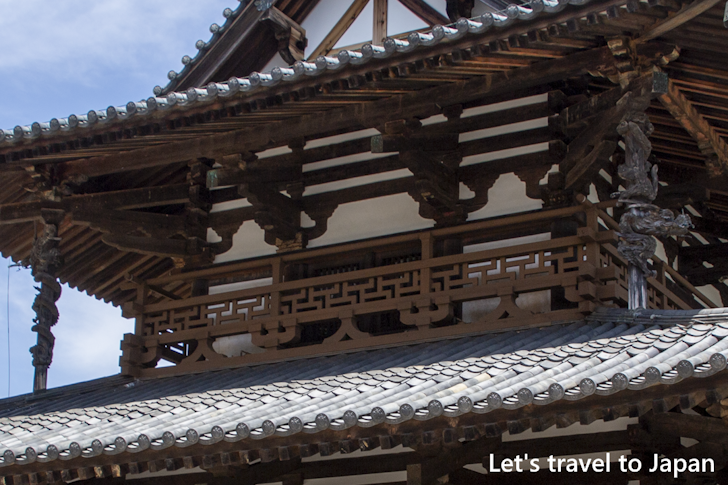
Goju-no-To
The Goju-no-To(Five-Storied Pagoda) of Horyuji Temple is the oldest pagoda in Japan. While the exact year of the current pagoda's reconstruction is not known, it is estimated to have been rebuilt before 711, around the same time as the Chumon. Therefore, it is a wooden tower built approximately 1,300 years ago and is designated as a National Treasure.
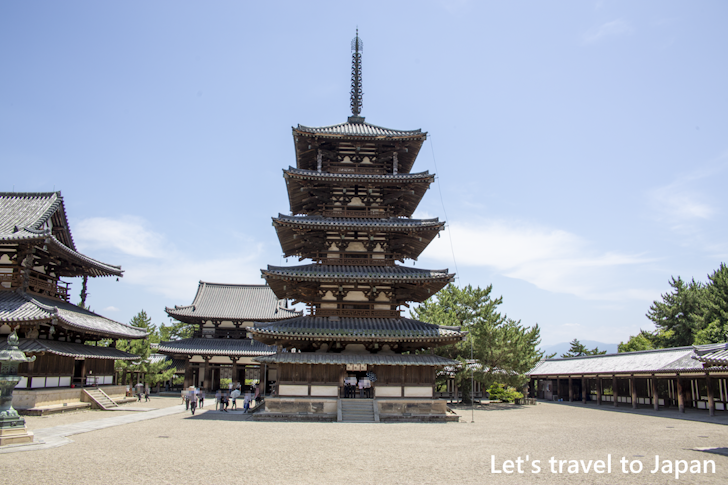
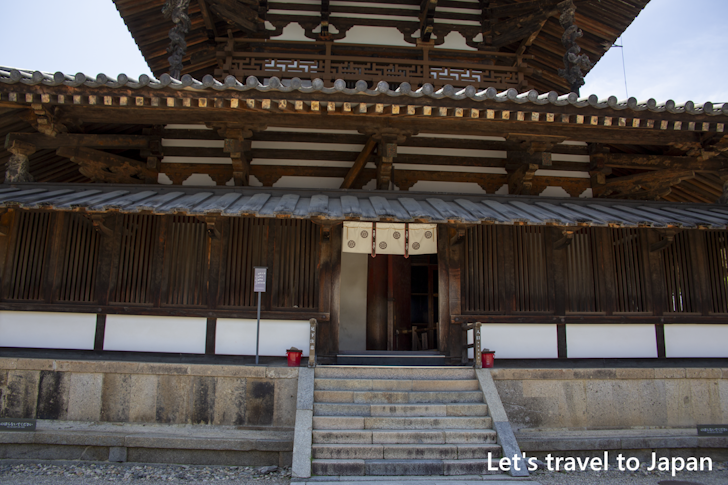
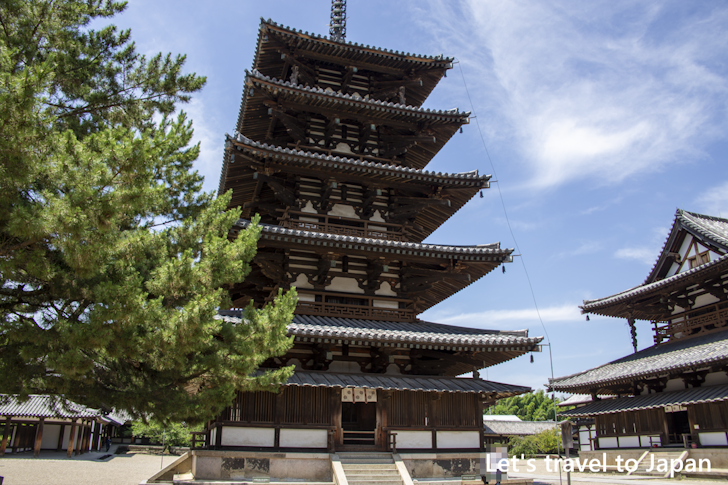
In the first layer of the Goju-no-To, a group of clay sculptures known as "Touhon Shimen-gu" are enshrined and can be viewed through a wire mesh. These sculptures depict four episodes related to the Buddha, and they are also designated as National Treasures.
Kairo,Shoro,Kyozo
From the Chumon, Kairo(corridors) extend to the left and right, leading to the Shoro(Bell Tower) on the east side and the Kyozo(Sutra Repository) on the west side. These Kairo also connect to the Daikodo(Great Lecture Hall) at the center, enclosing the Saiin Garan complex. The Kairo are believed to have been reconstructed around the same time as the Kondo and are designated as National Treasures.
Map of Saiin Garan:
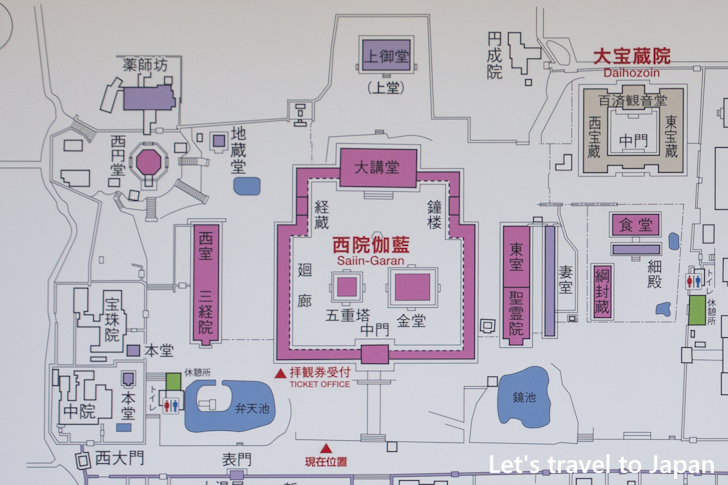
Kairo:
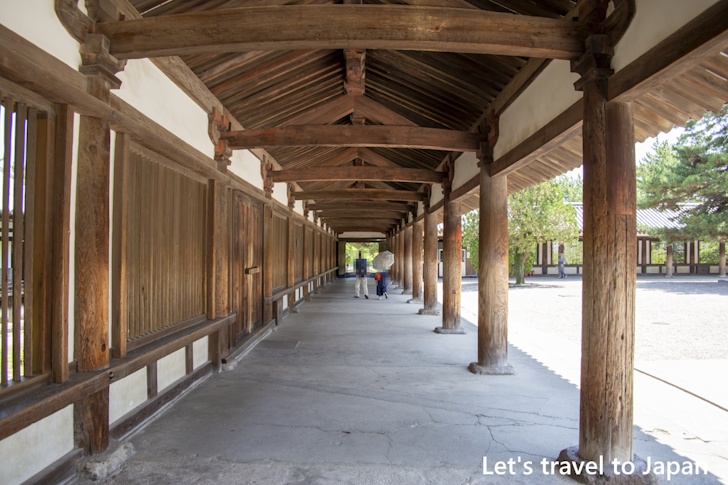
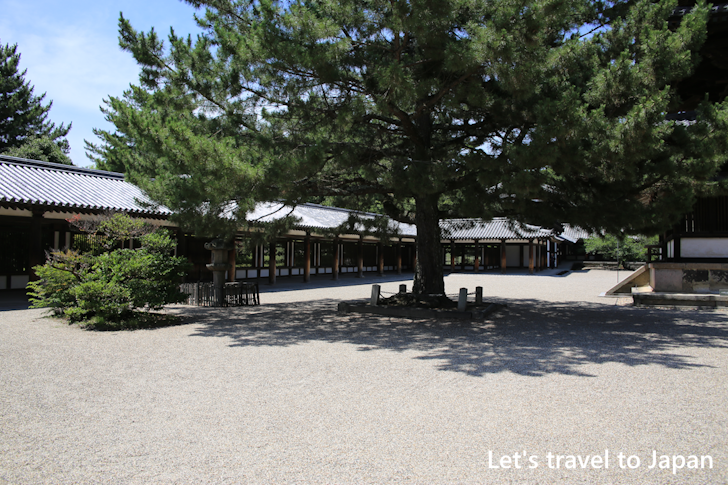
The Kyozo(Sutra Repository) was built during the Nara period, while the Shoro(Bell Tower) was rebuilt during the mid-Heian period after being destroyed by fire. Both are designated as National Treasures. Originally, the Kyozo, Shoro, and Daikodo were located outside the Kairo. However, when the Kairo were extended, they were connected to form the current layout.
Kyozo:
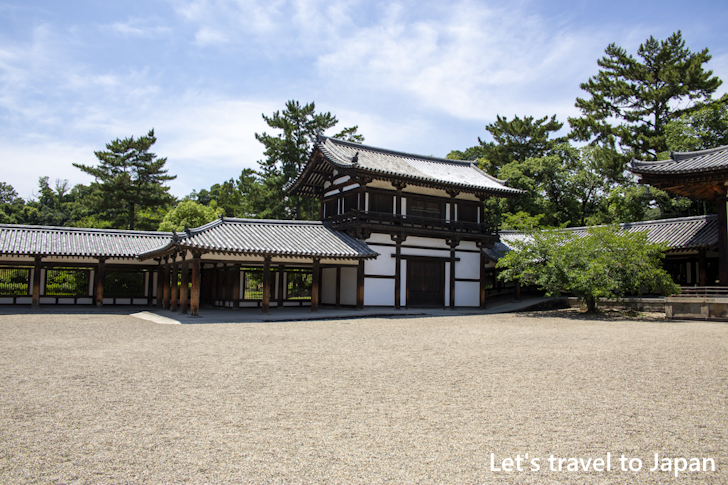
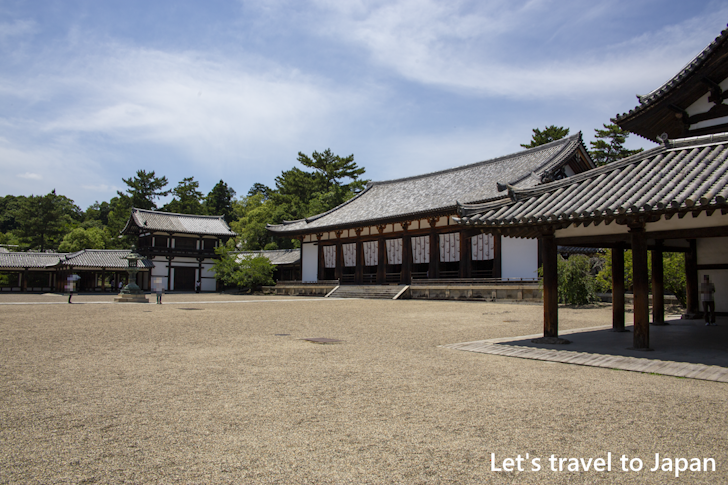
Shoro:
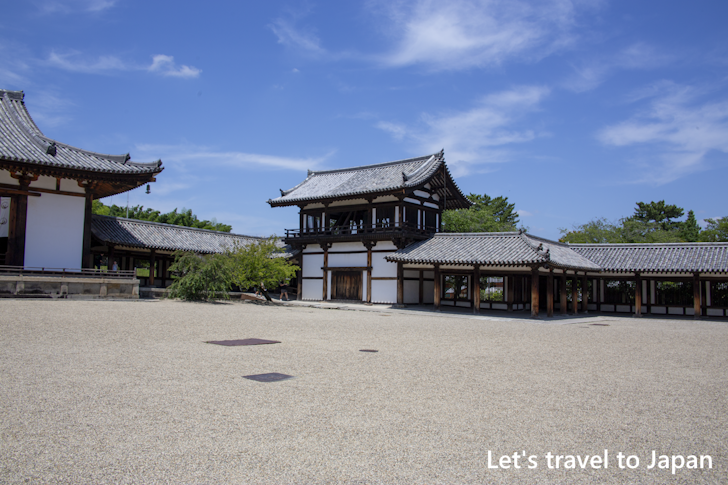
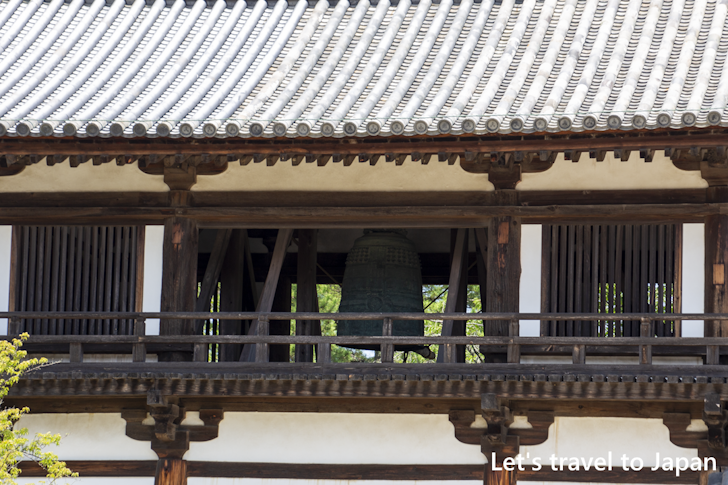
Daikodo
The Daikodo(Great Lecture Hall) was rebuilt in 990 after being destroyed by a lightning strike along with the Shoro. It is designated as a National Treasure. The Daikodo serves as a place where monks study Buddhism and where religious ceremonies are conducted. It is considerably larger than the Kondo.
The Daikodo houses a Yakushi Triad statue and Four Heavenly Kings statues, which were created when the hall was reconstructed.
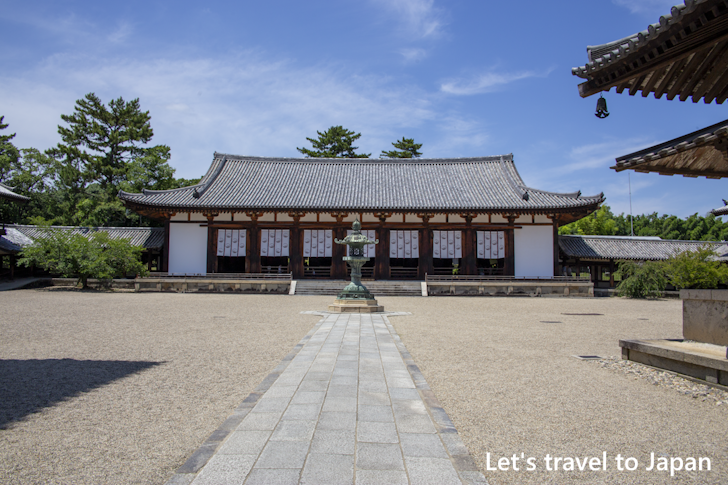
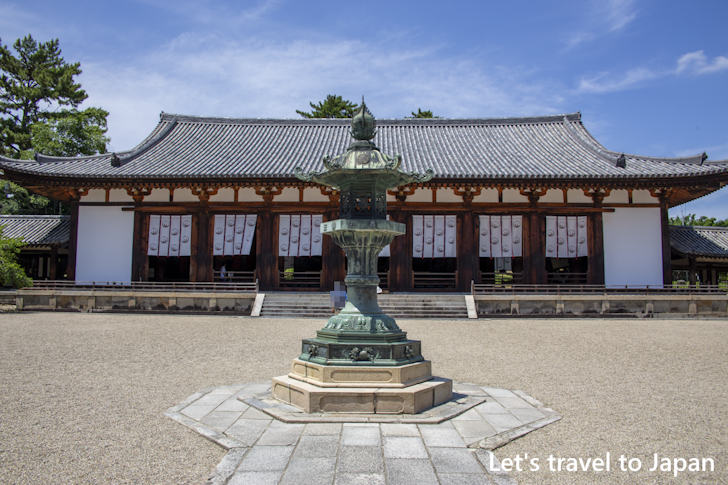
Shoryoin
Shoryoin is a Buddhist hall located on the east side of the Saiin Garan complex and houses a statue of Prince Shotoku. A portion of the Higashimuro(Eastern Room) was remodeled in 1284 to become Shoryoin. It is designated as a National Treasure.
Inside Shoryoin are three Zushi; the central one holds a statue of Prince Shotoku, the left one has statues of King Yamashiro-no-Ooeno and King Eguri, and the right one contains statues of King Somaro and the monk Eji. All five statues, including that of Prince Shotoku, are designated as National Treasures. Normally, the inside of the Zushi is not open to the public, but it is made available for viewing on March 22nd during the annual Oeshiki ceremony.
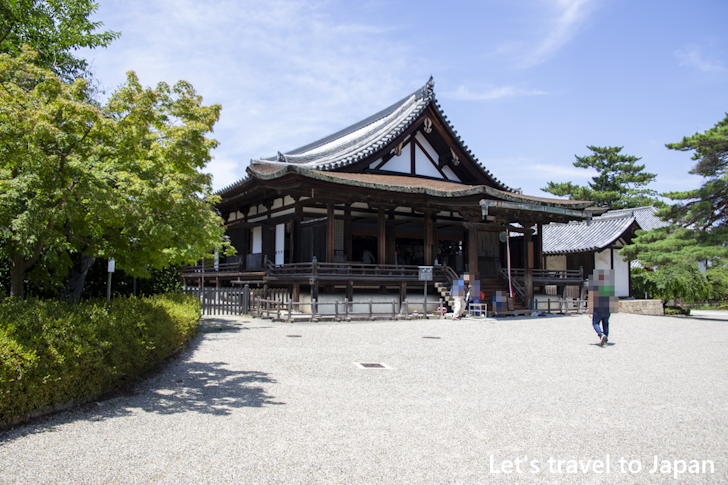
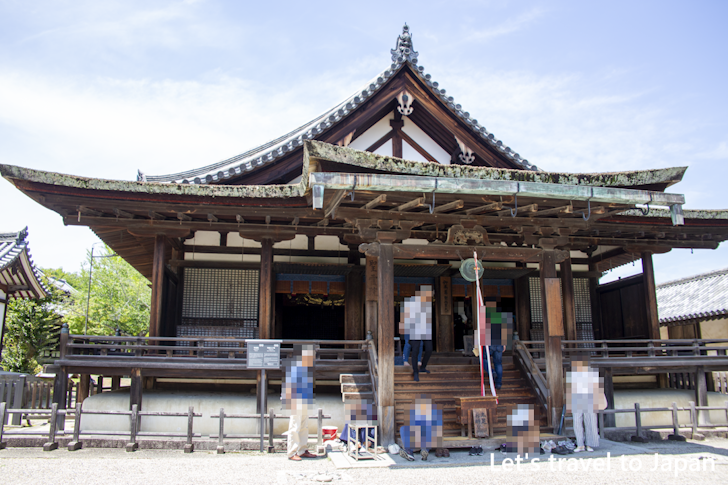
Daihozoin
The Daihozoin(Great Treasure Gallery) is a building complex centered around the Kudara Kannon Hall, flanked on both sides by the Touhouden(East Treasure Hall) and the Seihouden(West Treasure Hall). It houses and displays the temple treasures of Horyuji. Items such as the Tamamushi Shrine(Tamamushi Tabernacle) and the Kudara Kannon Statue are among its collection. All of these are designated as National Treasures.
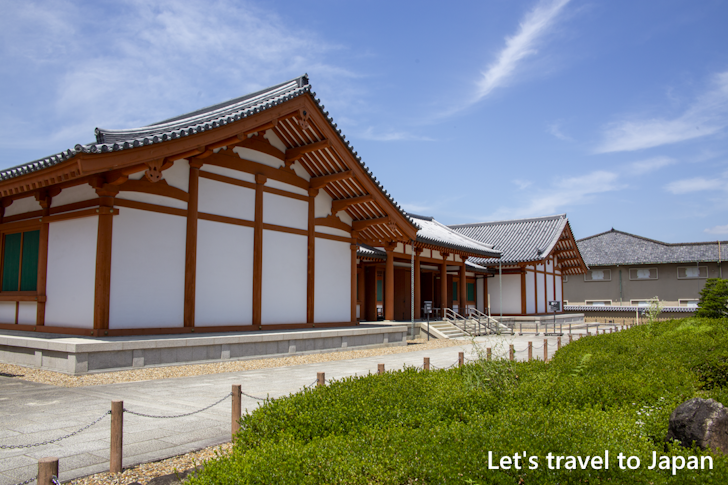
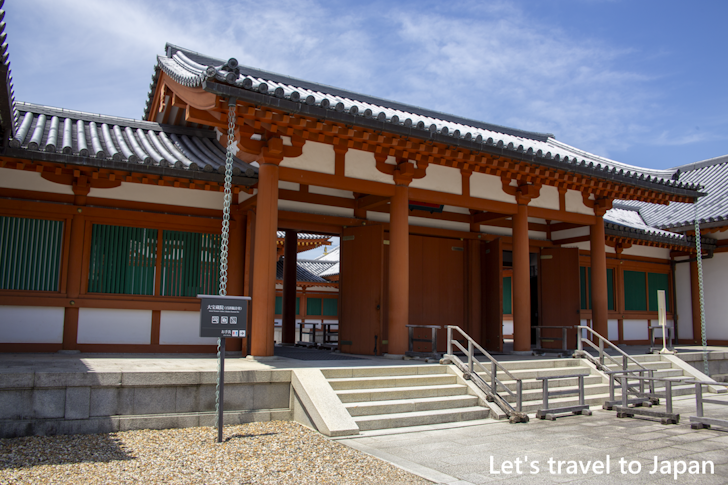
Toin Garan
The Toin Garan was built on the site of the Ikaruga Palace, which was once the residence of Prince Shotoku's family, for the purpose of memorializing Prince Shotoku. The complex includes the Yumedono(Hall of Dreams), Raido(Ceremonial Hall), the Eden(Painting Hall), the Shariden(Relic Hall), and the Toin Shoro(East Bell Tower), among others.
Toin Shoro:
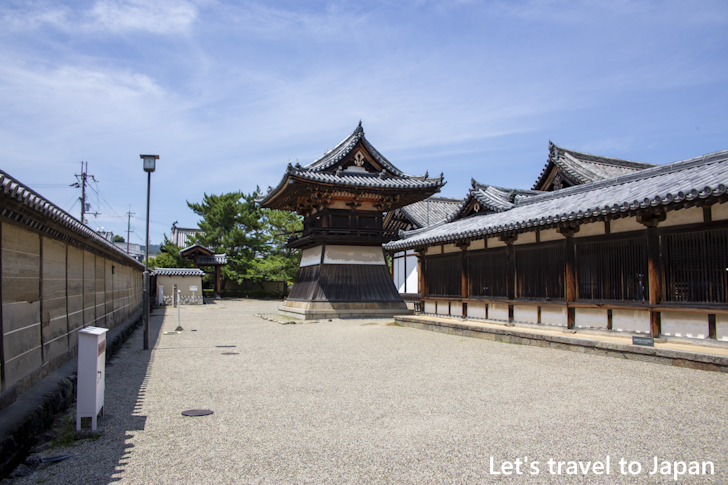
Eden and Shariden:
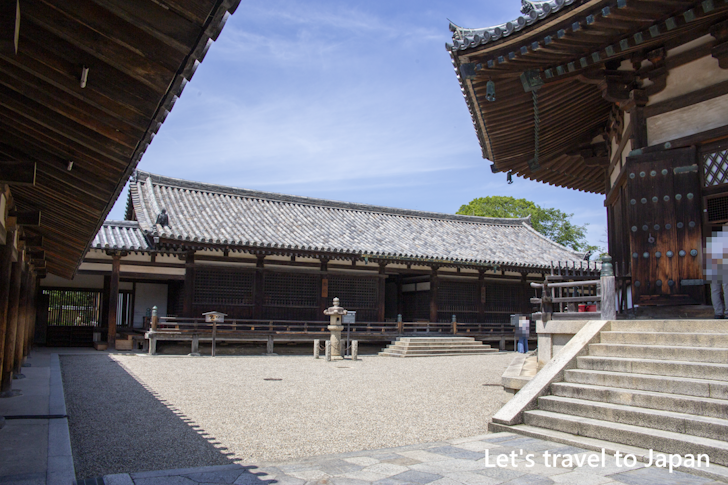
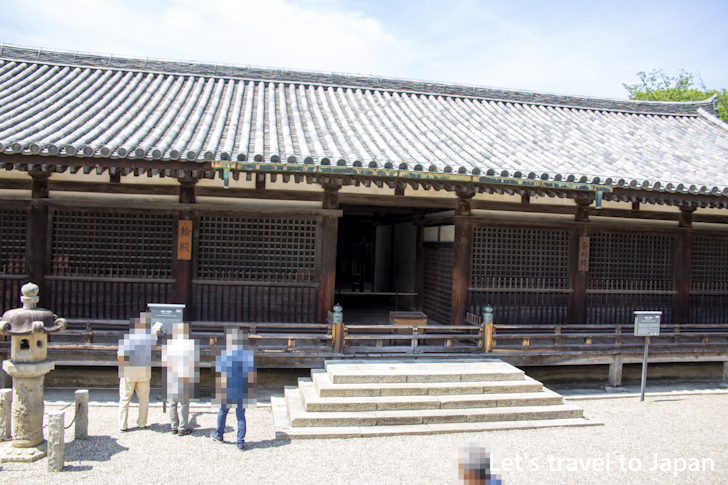
Yumedono
Yumedono is located in the center of Toin Garan. It was founded in the Nara period, but underwent major renovations in the Kamakura period. It has the shape of an octagonal hall, and a statue of Guze Kannon is enshrined inside the hall (usually not open to the public). Additionally, the roof is decorated with uniquely shaped jewels.
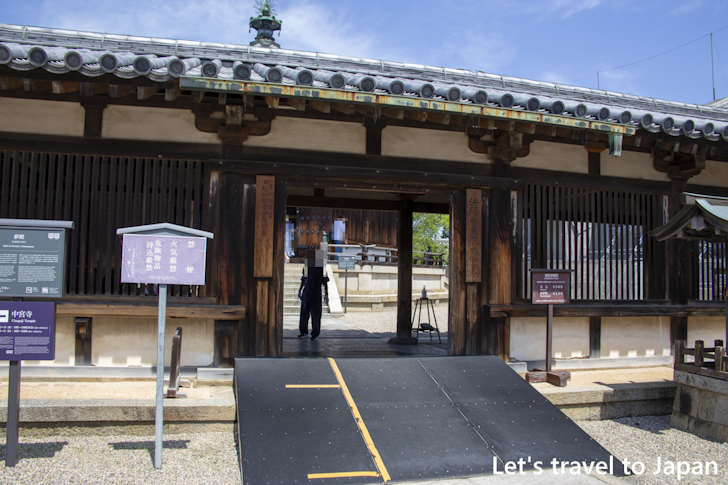
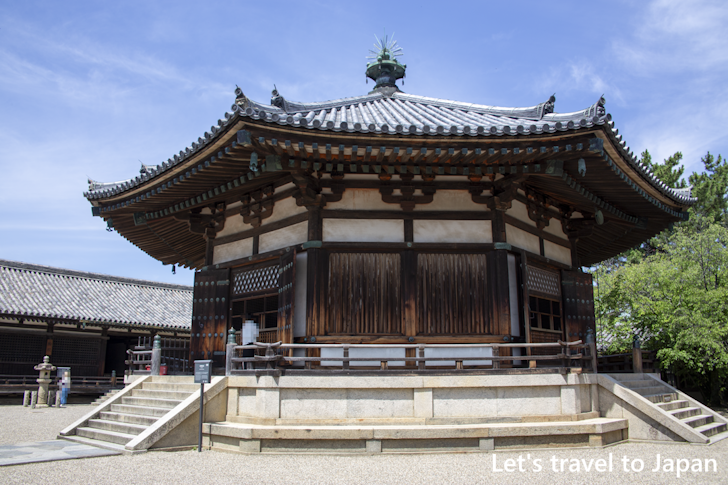
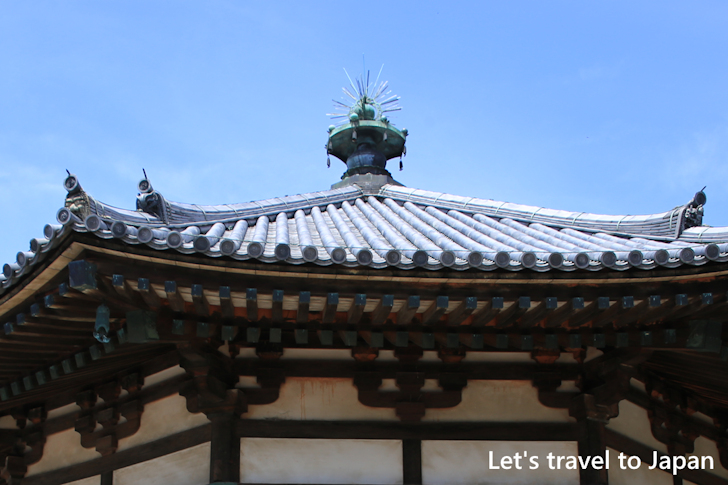
List of photos related to Horyuji Temple
Please see below for a list of photos related to Horyuji Temple.
Address and access method of Horyuji Temple
Address of Horyuji Temple
The address of Horyuji Temple is "1-1 Horyujisannai, Ikaruga-cho, Ikoma-gun, Nara Prefecture".
Access method of Horyuji Temple
I will explain how to access Horyuji Temple from JR Nara Station.
JR Yamatoji Line
11 minutes
Nara Kotsu Bus
8 minutes
Walking
5 minutes
Attractions near Horyuji Temple
Several notable attractions are located near Horyuji Temple:
Yakushiji Temple
Founded in 680 AD, Yakushiji is one of the most famous imperial temples in Japan. It is renowned for its unique architecture and beautiful pagodas.
Toshodaiji Temple
Founded in 759 AD by Chinese priest Ganjin, Toshodaiji Temple is an excellent example of Tang Dynasty architecture. It houses many national treasures, including ancient statues and paintings.
Nara Park
This beautiful park is home to hundreds of friendly deer, which are considered sacred messengers of the gods. Visitors can enjoy feeding and interacting with the deer in the park. Nara Park also includes attractions such as Todaiji Temple, housing the world's largest bronze Buddha statue, and Kofukuji Temple, known for its five-story pagoda.
Heijo Palace
This is the archaeological site of the ancient capital of Japan, Nara. The palace was built in 710 AD and served as the center of the Japanese government for more than 70 years. Visitors can explore the reconstructed buildings and learn about the history of the area at the on-site museum.
Naramachi
This historic district features narrow streets lined with traditional merchant houses, craft shops, and cafes. It's a great place to experience the traditional atmosphere of Nara, and you can also visit the Naramachi Mechanical Toy Museum to see a collection of traditional Japanese toys.
Other information about Horyuji Temple
Official site about Horyuji Temple :
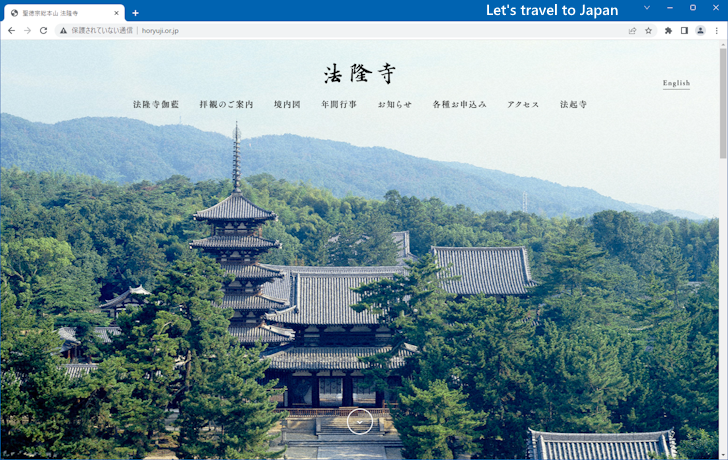
-- --
Thank you for reading to the end.
( Written by Tatsuo Ikura )